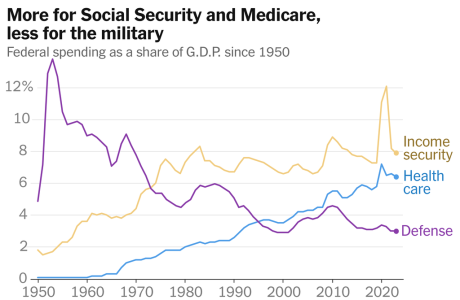‘The threats we face’
The first sentence of the report — released over the summer by a bipartisan, congressionally appointed commission — was blunt: “The threats the United States faces are the most serious and most challenging the nation has encountered since 1945 and include the potential for near-term major war.”The nation, the report continued, “is not prepared today.”
The threats begin with China, which has grown more belligerent in Asia. In Europe, Russia started the first major war in almost 80 years. In the Middle East, Iran finances a network of extremist groups. Increasingly, these countries work together, too, sometimes with North Korea. The report described them as “an axis of growing malign partnerships.”
I want to devote today’s newsletter to the findings from the group (officially known as the Commission on the National Defense Strategy) because I found them jarring — and because I suspect many readers haven’t yet heard them. “In a healthy political climate,” Walter Russell Mead, a foreign affairs expert at the Hudson Institute, wrote in The Wall Street Journal, the report would be “the central topic in national conversation.”
An anti-democracy alliance
This anti-American alliance presents a threat because its members are not satisfied with the status quo. That’s why Russia invaded Ukraine and Iran’s proxies have been so aggressive in Israel, Lebanon, Syria and Yemen. It’s why China has rammed Philippine boats in the South China Sea and President Xi Jinping has directed China’s military to be ready to invade Taiwan by 2027. China, Russia and Iran all want more control over their regions than they now have.One of the bipartisan group’s central arguments is that American weakness has contributed to the new instability. “This is not a report encouraging the U.S. to go to war,” Jane Harman, the former Democratic congresswoman from California and the commission’s chair, told me. “It’s a report making sure the U.S. can deter war.”
If the U.S. doesn’t do more to deter aggression, living standards in this country could suffer, Harman and her colleagues argued. Iran-backed attacks in the Red Sea have already raised shipping costs, while Russia’s invasion of Ukraine has made energy more expensive. A war in Taiwan could cut off access to the semiconductors that power modern life.
Harman told me that she believed the warning signs today were similar to those in the run-up to both Pearl Harbor and 9/11 — serious and underestimated.
American weaknesses
The report cited several major U.S. weaknesses, including:A failure to remain ahead of China in some aspects of military power. “China is outpacing the United States and has largely negated the U.S. military advantage in the Western Pacific through two decades of focused military investment,” the report concluded.
One reason is the decline in the share of U.S. resources devoted to the military. This Times chart, which may surprise some readers, tells the story:
The report recommended increasing military spending, partly by making changes to Medicare and Social Security (which is sure to upset many liberals) and partly by increasing taxes, including on corporations (which is sure to upset many conservatives). The report also called for more spending on diplomacy and praised the Biden administration for strengthening alliances in Europe and Asia.
A Pentagon bureaucracy that’s too deferential to military suppliers. The report criticized consolidation among defense contractors, which has raised costs and hampered innovation. The future increasingly lies with drones and A.I., not the decades-old equipment that the Pentagon now uses.
A U.S. manufacturing sector that isn’t strong enough to produce what the military needs. A lack of production capacity has already hurt the country’s efforts to aid Ukraine, as The Times has documented. “Putin’s invasion has demonstrated how weak our industrial base is,” David Grannis, the commission’s executive director, said. If the Pentagon and the innovative U.S. technology sector collaborated more, they could address this problem, Grannis added.
A polarized political atmosphere that undermines national unity. A lack of patriotism is one reason that the military has failed to meet its recent recruitment goals. Perhaps more worrisome, many Americans are angry at one another rather than paying attention to external threats.
The bottom line
A single commission won’t have all the answers to the hard strategic issues facing the country. How much money should the U.S. spend on the military, given other priorities and the large federal debt? How much waste can be cut from the Pentagon budget? Which foreign conflicts are vital to the national interest — and which are a distraction?All these questions are vexing. But Americans do face a more dangerous world than many realize. The unexpected global turmoil of the past decade makes that clear.



